January 24, 2024
The High Cost of Transportation in the United States
What does the average American pay to commute? What portion of their income is devoted to transportation? Is that cost typical across developed countries?
This article was updated from a previous version published in 2019.
Unfortunately, data shows that the portion of household expenditure spent on transportation in the United States (US) is often higher than that spent by people in other industrialized nations, due in large part to Americans’ car dependency. This difference is even more stark among low income earners and marginalized communities, even in spite of government efforts to subsidize transportation.
How Much Do Americans Pay for Transportation?
According to the US Department of Transportation, transportation remains one of the highest annual consumer expenditures, totaling $12,295 annually as of 2023. In 2021, while 90% of Americans had one car, nearly a quarter of the US population had three or more vehicles. In terms of total national household spending, transportation accounted for a total of $1.6 trillion USD, making it the fourth highest category of household expenditure in the country. After a decline in 2019-2020 due to the restrictions of the COVID-19 pandemic, between 2020-2021 the total national household spending on transportation continued to increase by nearly 30%.
The bulk of these costs go towards vehicle purchasing ($4,495.92 on average) followed by gasoline, other fuels, and motor oil ($3,119.74 on average). These numbers indicate that in the US especially, vehicle ownership is often an expensive and ongoing endeavor. In 2023, gasoline prices increased 25% due to constricted supplies and expanded demand, serving as a key driver of US consumer inflation over the past year. At the same time, Americans spend significantly less on other transport modes, such as public transit, despite the high expenses of owning and maintaining a private vehicle. The majority of an average households’ transportation expenses (93%) goes towards buying, maintaining, and operating cars.
Following the pandemic, spending on both intra-city and inter-city public transportation services have been slow to recover yet spending on private cars still rose by a double digit percentage in the face of high loan interest rates and increasing prices. It is also important to note that vehicles themselves are depreciating assets, so their value is rarely ever regained upon resale, while the maintenance costs continue to rise as a vehicle ages. Taken together, expenditures on owning and operating cars is the main contributor to Americans’ high spending on transportation.
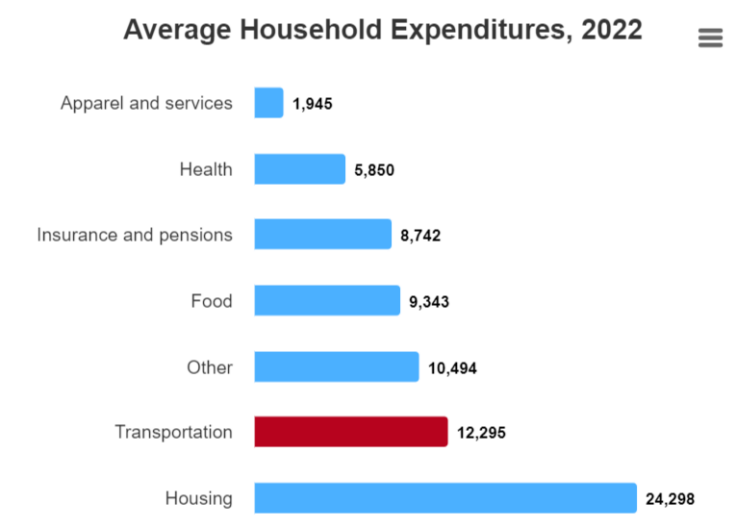
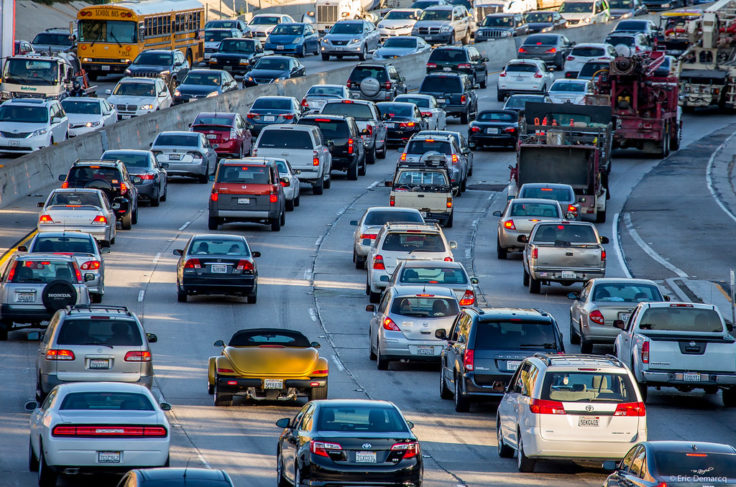
How Does Transportation Spending Impact Average Households?
The proportion of expenditures on transportation in the US is often inversely correlated with income. While the average American across all income levels spends roughly 16% of their household expenditures on transportation, these costs are not comparable across income brackets. Lower income households generally pay a larger portion of their budgets on transportation and, as people move up in income brackets, they pay less.
This can be contributed to higher income groups being allowed more transport options, more flexible employment opportunities, and more accessible housing. In 2022, low-income households spent an estimated 30% of their after-tax income on their transportation. When it comes to car ownership, households in the lowest fifth segment of incomes owned the fewest number of vehicles on average: one vehicle per household, compared to two or more in higher income households. Ultimately, the need to own a private vehicle in the US exacerbates both economic and social inequalities.
Personal vehicles are certainly cheap, and are often not subsidized to make equally affordable for everyone. As a result of many US cities lacking reliable, well-funded, and inclusive public transport options, people are forced to travel by personal vehicles to access essential destinations, like school or work. The lack of affordable, sustainable public transport options thus creates a noticeable financial burden on average American households – with fewer mobility options, many are forced to make difficult financial decisions that can impact quality-of-life.
Low-income communities of color are, as a result, disproportionately affected by a lack of access to reliable and accessible public transit services. This leads to many households in these communities having fewer financial resources and time to spend on other areas like education, housing, childcare, and healthcare because of the costs of private vehicle ownership. Those that go without cars are often thus often limited in economic and employment opportunities the further they live from urban cores.
This lack of access to sustainable transport exacerbates wealth, environmental, and health concerns for many marginalized populations. As the Urban Institute contends, in many cities, highly educated and higher income White residents tend to have greater access to public transport, and systemic differences make it easier for White residents to purchase a car if needed. In fact, compared to White workers, Black and Hispanic workers are nearly three times as likely to use public transit but, with housing values near stations nearly 24% higher than peripheral areas, affordable housing and accessible transit are often at odds.
Furthermore, chronically underfunded and maintained public transit infrastructure in many cities are made inaccessible to people with disabilities, children, caregivers, and older populations, leaving many without safe, convenient, or efficient ways to get to jobs, schools, hospitals, supermarkets, and beyond. ITDP’s Access for All series of resources provides further research and recommendations for decision-makers interested in planning for the needs of underrepresented communities through inclusive and universal design practices that make built environments better for all people, regardless of age, race, gender, or ability.
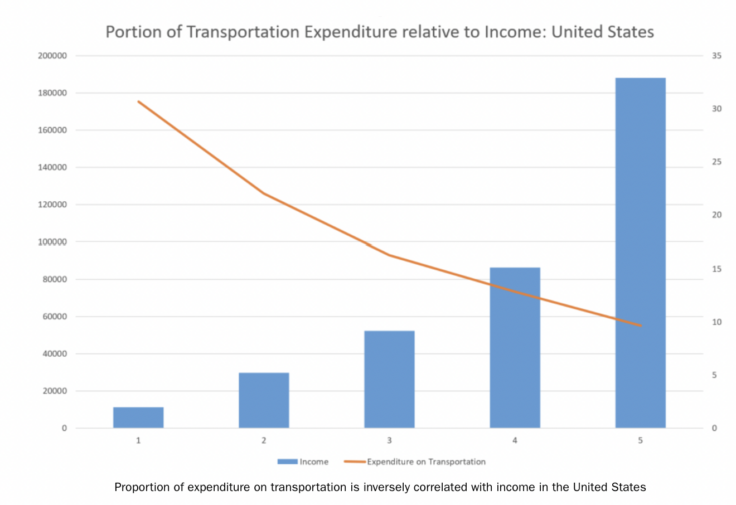
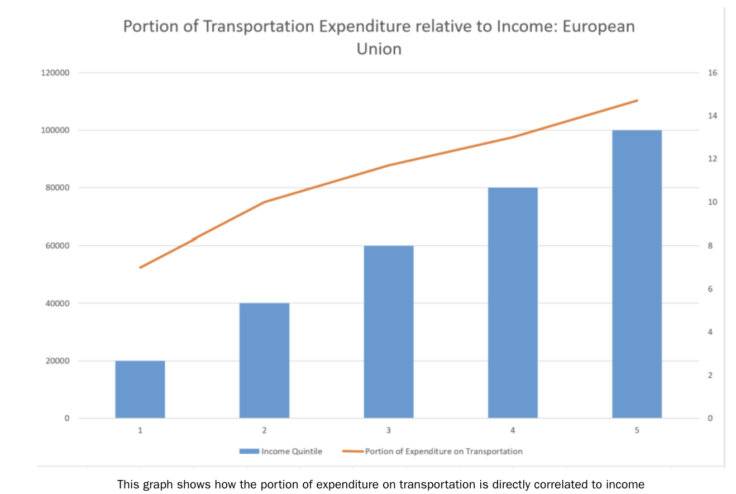
Is Change Possible?
Compared to the US, people in European countries spend a smaller portion of their income on transportation. This difference is most pronounced at lower income brackets, but remains consistent across incomes. According to 2023 European Union (EU) data, average Europeans households spend around 11% of their income on transport costs, about 5% less than the average American household. What is interesting to note in this comparison is that throughout Europe, numerous policies have existed for decades to discourage private vehicle use and encourage sustainable transport modes like walking, cycling, and public transit. Fuel is taxed, parking is limited, and toll roads and congestion pricing initiatives are well established.
At the same time, these costs do not contribute to an overall annual increase in the cost of transportation to individuals, as Europeans still pay less for transportation overall than Americans. Compared to the US, residents in Western Europe and Canada use public transportation at much higher rates and the presences of pedestrian and cycling infrastructure are commonplace in EU cities. Between 10% and 20% of urban commutes in Western Europe rely on public transit for their commutes, in comparison to just 2% in the US.
When looking at the pricing structure for European transportation, the fees and taxes associated with driving all also provide an important source of regular income to governing bodies and agencies. This allows for more money to go towards sustainable transportation to serve people in a wider array of communities. While political and public will remains a huge reason for the EU’s expansive public transport systems, so too does funding. With more funding available more broadly, not only are Europeans deterred from taking private vehicles – they often can save both time and money by choosing public transportation instead.
Subsidizing a common good through individual incomes may seems antithetical to most Americans, but it all relies on the framing. When most Americans outside of major cities think of public transportation they think of something they perceive as inconvenient, or as a service they would be paying into without any direct benefits. On the other hand, in Europe, the evidence is clear – when costs associated with driving are levied and applied to improving public transportation infrastructure, it becomes better, safer, cleaner, and more efficient for all. With common sense pricing policies, the revenue generated by reducing private vehicle usage has immense potential to improve, expand, and increase public transportation ridership.
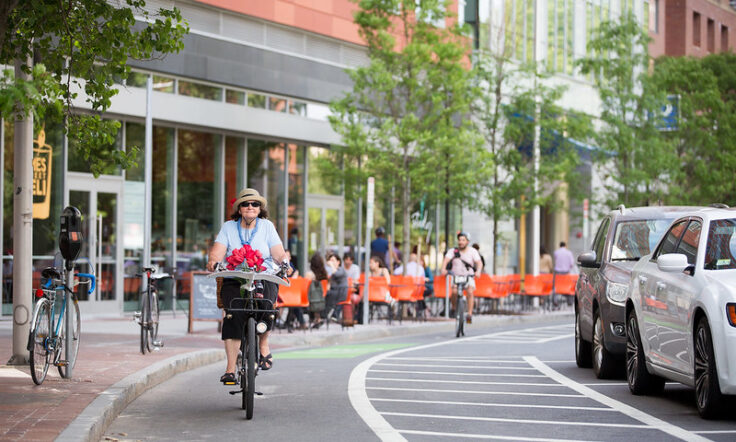
ITDP’s 2024 Compact Cities Electrified: United States outlines how electrification and compact planning can reduce private and public transport costs.
How Can We Make Transportation More Cost-Effective?
Few Americans take public transit, walk, or cycle to work and that is not for lack of interest – it can be attributed to the lack of accessible and integrated active mobility and transit infrastructure. Nearly 45% of Americans have no access to public transportation options at all. The antiquated designs of American cities and car-centric neighborhoods forces millions to pay for private transport that they otherwise may not choose if they had cheaper, safer options available. This lack of public transportation is a foundational reason why Americans continue to shell out more and more money for depreciating assets like private vehicles. How urban space and land use is approached and designed in the US is a major contributor to the high costs of transportation.
Antiquated residential zoning laws also force many neighborhoods to be separated from commercial districts. Single-family zoning accounts for 75% of housing in America, perpetuating urban sprawl and making many key services and destinations more difficult to access. It is well known that roads, highways, and suburban areas are designed to be car dependent, thus limiting options for public transit or other modes. Over 75% of commuting car trips in the country are made by one person in one vehicle – a reality that is inefficient in both time and space. Additionally, most car trips in the US are relatively short, under just six miles, a distance that could arguably be covered just as easily with public transportation if the right infrastructure and operations existed.
By focusing on the core principles of Transit Oriented Development, cities still have opportunities to create neighborhoods, streets, and public spaces that better support transit, cycling, and walking. ITDP and UC Davis’s Compact Cites Electrified report for the US finds that the US could feasibly reduce public-sector expenditures on urban transport at the city, state, and federal levels by a cumulative $2 trillion USD if they used a combination of strategies that support electrification, compact and mixed-use planning, and sustainable mobility. For individuals, the research estimates that by 2050, such shifts could save each urban American an average of $2,000 USD every year, a significant amount for low and mid-income households and families
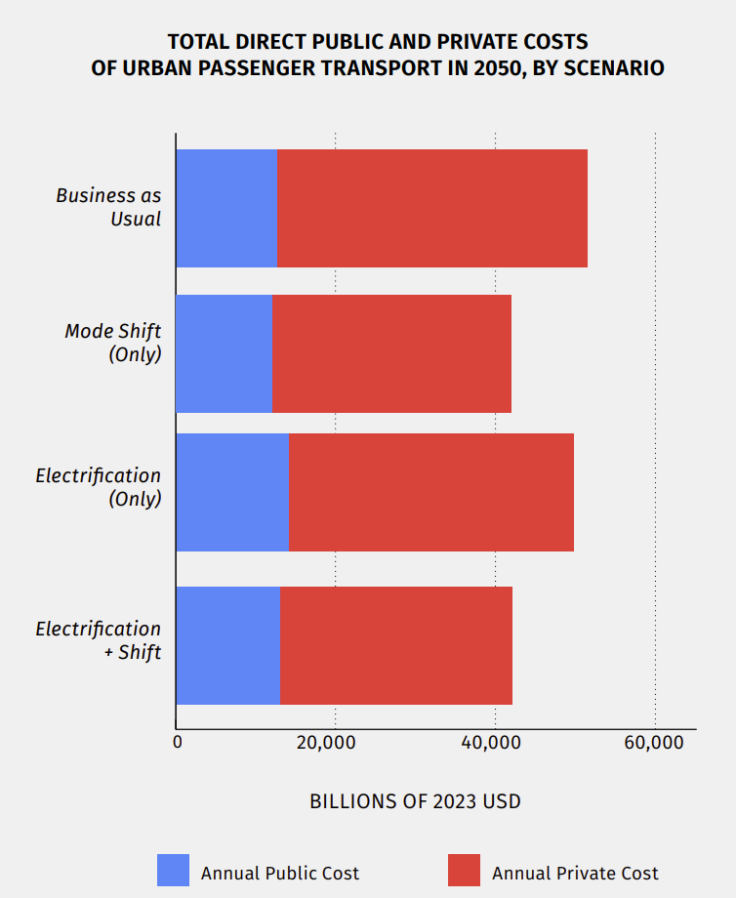
What’s more, investing in public transportation is also proven to be a source of job creation – by simply shifting spending away from roads and highways and into public transit, the US can create 20% more jobs without spending a single additional dollar. This has equity impacts as well: placing public transit in communities with high unemployment creates 2.5 times more jobs compared to low unemployment areas. The same can be said of investments in safe urban cycling infrastructure that lowers individual and city-level transport costs while generating jobs and reducing transport-related emissions.
In the end, affordable and comprehensive public transportation is certainly not a lost cause in the United States. Looking towards existing and burgeoning urban models, policymakers and individuals can learn how to shape and support cities that are less car reliant and better integrated for sustainable, inclusive, and holistic mobility systems. Not only will this create better built environments for air quality, road safety, and community engagement, it can greatly reduce the financial burdens inflicted on average Americans and those with the least resources.
For the US to break the cycle of high transport costs and expenses, there needs to be a concerted shift in how decision-makers and everyday Americans view their relationships with both private vehicles and public transportation.
